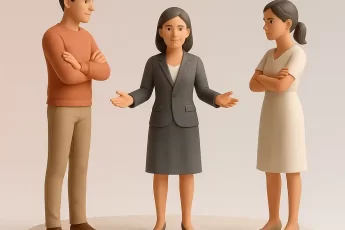 When parents separate or divorce, one of the most sensitive and important decisions they must make concerns the future care of their children. For many, reaching an agreement informally works well. But when consensus proves elusive, the courts may intervene by issuing a Child Arrangements Order (CAO) — a legal directive that sets out where a child lives, who they spend time with, and how that is managed. This guide explores what CAOs are, how they work, and what parents in England need to know.
When parents separate or divorce, one of the most sensitive and important decisions they must make concerns the future care of their children. For many, reaching an agreement informally works well. But when consensus proves elusive, the courts may intervene by issuing a Child Arrangements Order (CAO) — a legal directive that sets out where a child lives, who they spend time with, and how that is managed. This guide explores what CAOs are, how they work, and what parents in England need to know.
At Midwinters, we understand that these situations can be deeply emotional and legally complex. Our specialist family team, led by Partner Lucy Webley — a solicitor with over 25 years’ experience — offers clear, compassionate advice on all aspects of children disputes, divorce and separation, and more.
What is a Child Arrangements Order?
A Child Arrangements Order is a type of court order made under Section 8 of the Children Act 1989. It replaces what used to be known as residence and contact orders. The order determines:
– With whom a child is to live, or spend time with , and
– When a child is to live or spend time with any person.
In essence, it sets out the practical arrangements for a child’s day-to-day care and ongoing relationship with both parents (or others with parental responsibility), following separation.
Who Can Apply for a Child Arrangements Order?
You don’t need to be a parent to apply for a CAO. Individuals who may apply include:
– Parents, guardians, or special guardians
– Step-parents with parental responsibility
– Anyone the child has lived with for at least three of the past five years
– Grandparents or other relatives (with permission from the court)
If you’re unsure whether you qualify to apply, our team at Midwinters can assess your situation during a free initial half-hour consultation and advise on your legal standing.
When is a Child Arrangements Order Necessary?
Many separating parents reach agreement amicably and without court intervention. However, a CAO may become necessary when:
– There is a dispute about where the child should live
– One parent is time with the child unfairly
– There are safeguarding concerns or a risk of harm
– Parental conflict has made informal agreements unworkable
At Midwinters, we help parents navigate these scenarios with empathy and clarity. Whether you’re facing a cohabitation dispute, divorce, or civil partnership dissolution, we can advise on all child-related legal implications.
The Welfare Principle: What Will the Court Consider?
The court’s paramount concern is always the child’s welfare. Decisions are guided by a ‘welfare checklist’ from the Children Act 1989, which considers:
- The child’s wishes and feelings, depending on age and understanding
- Their physical, emotional, and educational needs
- The likely effect of any changes
- The child’s background, including age and characteristics
- Any risk of harm or abuse
- The capability of each parent or applicant to meet the child’s needs
The court begins with the presumption that involvement by both parents is beneficial — unless there is evidence to the contrary.
The Application Process
Applying for a CAO generally involves the following stages:
1. Attempting Mediation
Most applicants must attend a Mediation Information and Assessment Meeting (MIAM) before applying to court. Mediation aims to resolve issues amicably, but exemptions exist for cases involving domestic abuse or urgent concerns.
2. Filing the Application
Applicants complete a Form C100 outlining the orders they seek. Supporting documentation may be necessary, particularly if there are concerns around safety or welfare.
3. Safeguarding Checks and CAFCASS Involvement
The court notifies CAFCASS (Children and Family Court Advisory and Support Service), who conduct background checks and often contact both parties. They will usually provide a short report ahead of the first hearing.
4. First Hearing Dispute Resolution Appointment (FHDRA)
This initial court hearing focuses on encouraging agreement and narrowing the issues. Directions may be given for further evidence or hearings if necessary.
5. Final Hearing and Decision
If agreement isn’t reached, the case may progress to a final hearing. Here, a judge considers all evidence and makes a binding order based on the child’s best interests.
Our family law team can assist with every stage of the process, offering practical support whether you’re just beginning mediation or already facing a contested hearing.
What Can a Child Arrangements Order Include?
A CAO can be tailored to your child’s and family’s unique needs. It may specify:
- Which parent the child lives with, or whether time is shared
- Contact arrangements, such as overnight stays, phone calls or digital contact
- Special arrangements for holidays, birthdays or school terms
- Restrictions or protections — for instance, supervised contact or prohibiting removal from the UK
If you’re unsure how best to shape these arrangements, Lucy and her experienced PA Linda offer a calm, clear-headed approach to help you build the right plan.
How Long Does a Child Arrangements Order Last?
A CAO typically remains in force until the child reaches 16, or sometimes 18 if exceptional circumstances apply. However, orders can be reviewed and changed if your situation changes significantly.
This might include a change in school, new living arrangements, or evolving needs as your child grows. Our team can assist with variation applications and advise whether returning to court is appropriate.
Enforcing a Child Arrangements Order
If the other party fails to comply with the CAO, the court can enforce it. Available measures include:
- Enforcement orders (e.g. unpaid work requirements)
- Compensation for financial loss (such as missed holidays)
- Varying the order if the current terms are no longer viable
- In serious cases, issuing fines or even considering changes in residence
The emphasis is always on securing stability for the child — not punishing parents unnecessarily.
Other Related Legal Issues
Many clients come to us with wider questions relating to separation and family life. At Midwinters, we don’t just deal with child arrangements. We also offer expert legal advice and support with:
- Divorce and separation
- Dissolution of civil partnerships
- Financial and property settlements
- Living together agreements
- Cohabitation disputes
- Pre-nuptial and post-nuptial agreements
All of these issues can impact child arrangements, and we’ll help you understand the full legal picture, ensuring your decisions are robust and informed.
Practical Tips for Parents
- Document any agreements or concerns — especially where communication has broken down
- Use shared calendars or parenting apps to reduce misunderstandings
- Be consistent and child-focused when discussing arrangements
- Try to avoid involving children in adult disputes
- Seek legal advice early to avoid unnecessary escalation
Start with a Free Consultation
Midwinters offers free initial half-hour meetings for new clients — available in person, by telephone or virtually. During this time, we’ll listen to your situation, explain your options, and outline the next steps clearly and sensitively.
You can get started online here for tailored information or call 01242 514674 to speak directly with Lucy or Linda. Whether you’re considering your first steps after separation or dealing with a long-standing disagreement, we’re here to support you with thoughtful, professional advice.





